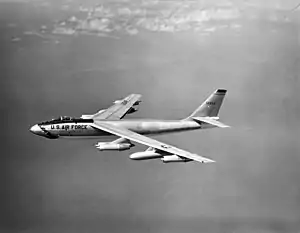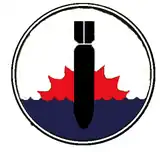| 424th Bombardment Squadron | |
|---|---|
 B-47E Stratojet as flown by the 424th at Lincoln AFB[lower-alpha 1] | |
| Active | 1942–1945; 1953–1954; 1958–1962 |
| Country | |
| Branch | |
| Role | Bombardment |
| Engagements | South Pacific Theater, Southwest Pacific Theater[1] |
| Decorations | Distinguished Unit Citation Philippine Presidential Unit Citation[1] |
| Insignia | |
| 424th Bombardment Squadron emblem[lower-alpha 2][1] |  |
The 424th Bombardment Squadron is an inactive United States Air Force unit. Its last assignment was with the 307th Bombardment Wing at Lincoln Air Force Base, Nebraska, where it was inactivated on 1 January 1962.
The squadron was first activated in April 1942 as the 34th Reconnaissance Squadron, one of the original four squadrons of the 307th Bombardment Group, but was redesignated the 424th Bombardment Squadron shortly afterwards. After training in the United State, it deployed to the Pacific, serving mainly in the Southwest Pacific Theater. The squadron earned two Distinguished Unit Citations for its actions in combat. Following V-J Day, it returned to the United States for inactivation.
The squadron was activated as a light bomber crew training unit during the Korean War, replacing an Air National Guard unit that had been mobilized for the war and was returning to state control. It was inactivated and its personnel and equipment transferred to another unit in connection with the upgrade of the unit to jet bombers. It was activated again in 1958 when Strategic Air Command (SAC) expanded its Boeing B-47 wings from three to four squadrons. When SAC's alert commitment changed, it was inactivated in 1962.
History
World War II

Formed as a heavy bombardment squadron in January 1942, trained in the Pacific Northwest under Second Air Force, with Boeing B-17 Flying Fortresses. Reassigned to Seventh Air Force in Hawaii, November 1942 and performed performing search and rescue and antisubmarine patrols until January 1943 while transitioning to long-range Consolidated B-24 Liberator heavy bombers.
Deployed to the Central Pacific from Hawaii throughout 1943 for long-range combat bombardment operations against Japanese forces in the Central Pacific; New Guinea; Northern Solomon Islands and Eastern Mandates campaigns. Deployed to the New Hebrides in Melanesia and operated from numerous temporary jungle airfields, engaging in long-range bombardment operations during the Bismarck Archipelago; Western Pacific; Leyte; Luzon and Southern Philippines campaigns until the end of the war in August 1945. Assigned to Clark Field, Philippines after the war ended, demobilized with personnel returning to the United States, unit inactivated as paper unit in January 1946 in California.
Light bomber crew training
.jpg.webp)
During and immediately after the Korean War, Tactical Air Command (TAC) trained aircrews for the Douglas B-26 Invader at Langley Air Force Base, Virginia. The three squadrons of the 4400th Combat Crew Training Group performing this mission were Air National Guard units that had been mobilized for the war. At the start of 1953, these squadrons were returned to state control and the 424th was activated[1] and took over the mission, personnel, and equipment of the 122d Bombardment Squadron, which returned to the Louisiana Air National Guard.[2] In January 1954, the group mission shifted to tactical bombardment and it was redesignated the 4400th Bombardment Group. As the group began to anticipate the transition to Martin B-57 Canberra aircraft, TAC decided to replace the Table of Distribution 4400th Group and its squadrons with the regular 345th Bombardment Group, which took over their mission in July 1954[3] and the 424th was inactivated.[1]
Strategic Air Command
The squadron was activated for a third time in September 1958 as Strategic Air Command (SAC)'s Boeing B-47 Stratojet fleet reached a peak of twenty-seven wings[4] In 1958, the Boeing B-47 Stratojet wings of SAC assumed an alert posture at their home bases, reducing the amount of time spent on alert at overseas bases. The SAC alert cycle divided itself into four parts: planning, flying, alert and rest to meet General Thomas S. Power's initial goal of maintaining one third of SAC's planes on fifteen minute ground alert, fully fueled and ready for combat to reduce vulnerability to a Soviet missile strike.[5] To implement this new system B-47 wings reorganized from three to four squadrons.[5][6] The 424th was activated at Lincoln Air Force Base, nebraska as the fourth squadron of the 307th Bombardment Wing.[1] The alert commitment was increased to half the squadron's aircraft in 1962 and the four squadron pattern no longer met the alert cycle commitment, so the squadron was inactivated on 1 January 1962.[1][6]
Lineage
- Constituted as the 35th Reconnaissance Squadron, (Heavy) on 28 January 1942
- Activated on 15 April 1942
- Redesignated 424th Bombardment Squadron (Heavy) on 22 April 1942
- Redesignated 424th Bombardment Squadron, Heavy in 1944
- Inactivated on 26 December 1945
- Redesignated 424th Bombardment Squadron, Light on 15 November 1952
- Activated on 1 January 1953
- Inactivated on 19 July 1954
- Redesignated 424th Bombardment Squadron, Medium on 11 August 1958
- Activated on 1 September 1958
- Discontinued and inactivated on 1 January 1962[1]
Assignments
- 307th Bombardment Group, 15 April 1942 – 26 December 1945
- 4430th Air Base Wing (attached to 4400th Combat Crew Training Group), 1 January 1953
- 4400th Combat Crew Training Group (later Bombardment Group), 1 May 1953 – 19 July 1954
- 307th Bombardment Wing, 1 September 1958 – 1 January 1962[1]
Stations
|
|
Aircraft
- Boeing B-17 Flying Fortress, 1942
- Consolidated B-24 Liberator, 1942–1945
- Douglas B-26 Invader, 1953–1954
- Boeing B-47 Stratojet, 1958–1961[1]
See also
References
Notes
- Explanatory notes
- ↑ Aircraft is Boeing B-47E-55-BW Stratojet, serial 51-2394. In March 1960, it was modified as an NB-47E.
- ↑ Approved 24 February 1943. Description: A disc piped black, per fess debased engrailed argent and azure, issuing from partition line a red sun rayed proper, surmounted by a black aerial bomb palewise, point to base.
- ↑ Aircraft is Consolidated B-24D-50-CO, serial 42-40323. This aircraft flew 104 combat missions in the Pacific. Photo taken: 8 September 1944, Wakde Airfield, Netherlands East Indies. It was condemned on 31 October 1944. Baugher, Joe (7 September 2023). "1942 USAF Serial Numbers". Joe Baugher. Retrieved 30 November 2023.
- Citations
- 1 2 3 4 5 6 7 8 9 10 11 Maurer, Combat Squadrons. pp. 520-521
- ↑ See Mueller, p. 315
- ↑ See Maurer, Combat Units, pp. 225–226
- ↑ See generally wings and equipment listed in Ravenstein.
- 1 2 Schake, p. 220 (note 43)
- 1 2 "Abstract (Unclassified), History of the Strategic Bomber since 1945 (Top Secret, downgraded to Secret)". Air Force History Index. 1 April 1975. Retrieved 4 March 2014.
Bibliography
![]() This article incorporates public domain material from the Air Force Historical Research Agency.
This article incorporates public domain material from the Air Force Historical Research Agency.
- Maurer, Maurer, ed. (1983) [1961]. Air Force Combat Units of World War II (PDF) (reprint ed.). Washington, DC: Office of Air Force History. ISBN 0-912799-02-1. LCCN 61060979.
- Maurer, Maurer, ed. (1982) [1969]. Combat Squadrons of the Air Force, World War II (PDF) (reprint ed.). Washington, DC: Office of Air Force History. ISBN 0-405-12194-6. LCCN 70605402. OCLC 72556.
- Mueller, Robert (1989). Air Force Bases, Vol. I, Active Air Force Bases Within the United States of America on 17 September 1982 (PDF). Washington, DC: Office of Air Force History. p. 315. ISBN 0-912799-53-6.